Explore Dubai's Old Souk: Hours, Tips, and Insights
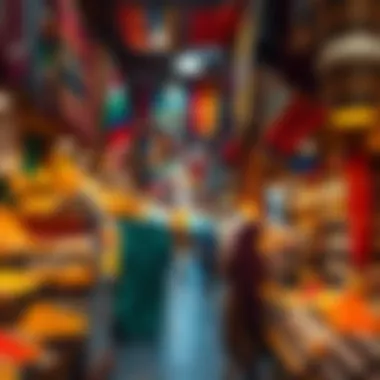
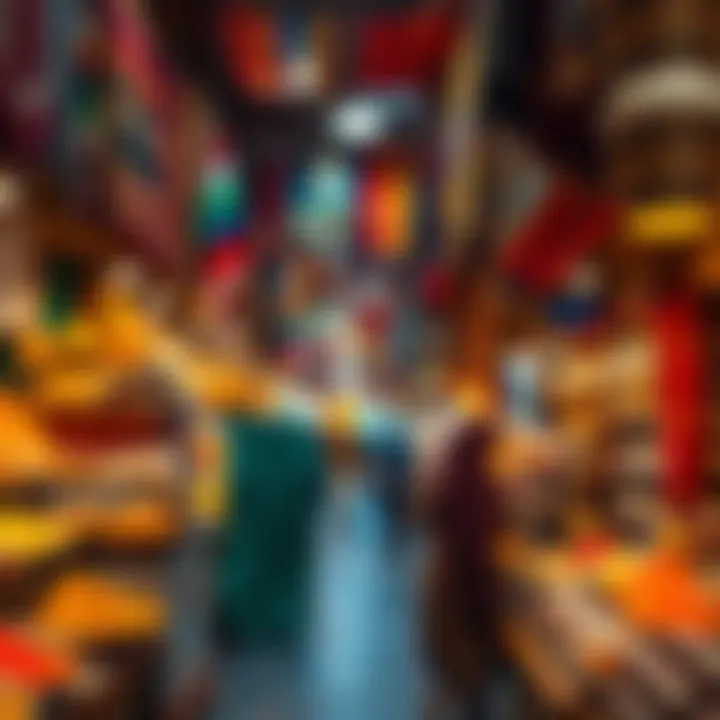
Intro
The Old Souk in Dubai is a vibrant tapestry woven with the threads of history, culture, and commerce. Nestled along the banks of the Dubai Creek, this bustling marketplace offers visitors a glimpse into the region’s trading past, blending tradition with modernity. As the city's heartbeat, the souk has witnessed centuries of deals, barter, and cultural exchange, serving as a historical marker amid contemporary skyscrapers.
When strolling through the narrow alleyways, the air is filled with enticing aromas of spices, incense, and the whisper of silk fabrics inviting you closer. For both residents and tourists, the experience here is not just about shopping; it’s about connection. As you wander from one vendor to the next, rich stories unfold—of merchants hailing from various corners of the globe, each bringing their unique flavors to this dynamic marketplace.
This guide aims to peel back the layers of the Old Souk, offering insights into its operational hours, significance, and practical tips for navigational ease. Whether you are a local seeking to rediscover this gem or a visitor eager to dive into its depths, understanding this souk can enhance your experience manifold. So, lace up your walking shoes, and let’s dive into the delightful chaos of Dubai's historical marketplace.
Understanding the Old Souk
The Old Souk in Dubai is not just a market; it's a living testament to the city's history and culture. Understanding this iconic destination is crucial for grasping how it fits into the broader cultural tapestry of Dubai. For investors, homebuyers, realtors, and analysts, having a comprehensive grasp of the Old Souk can inform decisions about property values and community dynamics in the surrounding areas.
Historical Context
The Old Souk, also known as the Textile Souk, has its roots in the late 19th century. Originally established as a trading hub, it played a vital role in Dubai's economic development. The market was known for its vibrant atmosphere filled with sounds of merchants negotiating deals. During its heyday, traders from various regions brought goods ranging from spices to textiles. This exchange of goods was not merely a business transaction but a cultural exchange that shaped the identity of the city.
After the discovery of oil in the 20th century, many of these traditional markets faced challenges as modern shopping malls began to sprout across Dubai. However, the Old Souk has resisted the winds of change, maintaining its authenticity and serving as a crucial economic and cultural site.
Architectural Significance
Architecturally, the Old Souk showcases a unique blend of traditional Emirati design and practical construction. The use of wind towers, known as barjeel, for ventilation is emblematic of how the builders adapted to the local climate. The narrow alleyways and winding paths of the souk create a sense of intimacy, encouraging visitors to explore at a leisurely pace. The buildings, often adorned with intricate wooden window screens, mirror traditional Arabian aesthetics.
In recent years, there have been efforts to conserve the architectural integrity of the Old Souk, ensuring that its original charm remains intact for future generations. This preservation not only draws tourists but also supports local artisans and craftsmen who rely on the tourism flow for their livelihoods.
Cultural Importance
Culturally, the Old Souk serves as a hub for local traditions and practices. It is a space where visitors can experience authentic Emirati culture firsthand. Local artisans often showcase their traditional handicrafts, such as pottery and textiles, within the market. This provides insight into the local culture, and it reflects a way of life that has persisted despite rapid modernization in other parts of Dubai.
Events and festivals frequently take place in and around the Old Souk, fostering community engagement and celebrating cultural heritage. For instance, during the Eid festivities, the souk transforms into a vibrant space filled with decorations, celebrations, and various performances—giving both locals and tourists a chance to immerse themselves in the spirit of the occasion.
The Old Souk is more than just a place to shop; it encapsulates the essence of Dubai's heritage, providing a glimpse into its past and a place to celebrate its cultural vibrancy today.
Opening Hours of the Old Souk
In the bustling heart of Dubai, the Old Souk stands as a bridge linking the past and present. Recognizing its opening hours is crucial for anyone looking to absorb the vibrant atmosphere and rich culture that this trading hub offers. Knowing when the souk opens and closes not only maximizes your experience but also aligns you with the rhythms of local life. This section will delve into the regular operating hours, seasonal variations, and holiday timings of the Old Souk.
Regular Operating Hours
The Old Souk typically operates daily, welcoming visitors from 10:00 AM until 10:00 PM. However, it's essential to consider slight variations that may occur. Visitors in the early hours can enjoy a quieter ambiance, perfect for exploring the intricate shops without the crowds. Moreover, as daylight wanes, the market transforms, illuminated by faint lights that cast a warm glow on the labyrinth of pathways.
Key Considerations:
- Best Times to Visit: Mornings offer cooler temperatures and more room to navigate, while evenings are lively with both locals and tourists.
- Local Customs: Be mindful that Fridays often see reduced operating hours due to Islamic practices, usually opening later at around 4:00 PM.
Seasonal Variations
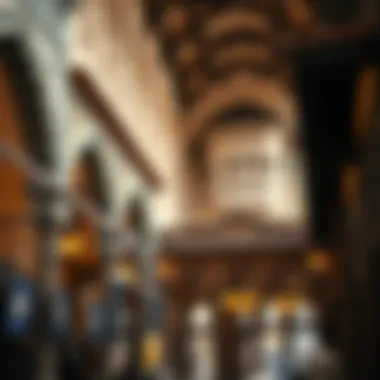
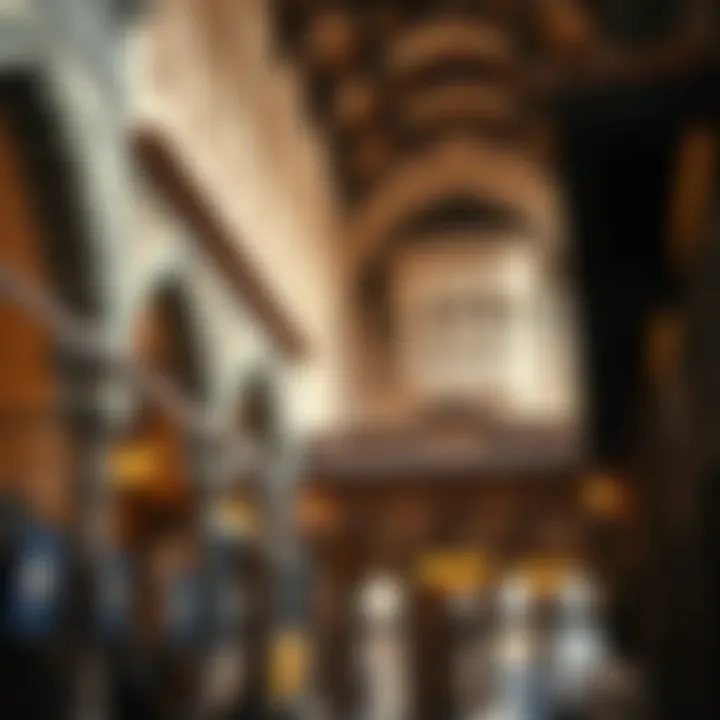
During the hotter months, particularly from June to September, the Old Souk’s hours might shift slightly. The intense heat can make the daytime experience tough, prompting many shops to open later. Visitors during this period might find that many stalls start their business around noon, closing a little later, perhaps up to midnight. This change caters to both local clientele and tourists who prefer to explore in the cooler evening air.
Tips for Seasonal Visits:
- Hydration: Always carry water and stay hydrated, especially if walking through the market during the day.
- Dressing Comfortably: Light, breathable clothing can make your experience much more enjoyable during the heat.
During Holidays
Holiday seasons in Dubai, such as Eid and National Day, warrant special attention regarding the Old Souk's opening hours. During these times, many shops may close to allow owners to celebrate with family. However, popular souvenir stalls and eateries might remain open to welcome tourists keen on experiencing local festivities. It’s advisable to check closer to the date, as hours can fluctuate based on the holiday's significance.
Holiday Visit Insights:
- Cultural Events: Leverage your visit to witness traditional celebrations and performances that often happen near the souk.
- Crowd Management: Expect larger crowds during holidays; a little patience goes a long way in these bustling markets.
Understanding the opening hours enhances your experience at the Old Souk, allowing you to plan your visit efficiently while soaking in its historical essence. By keeping these timings in mind, you can truly appreciate the beauty and vibrancy of one of Dubai’s most cherished gems.
Navigating the Souk
Navigating the Old Souk is like finding your way through a living museum. It’s full of twists and turns, and every corner reveals something new. To truly appreciate this historic market, it’s essential to grasp its layout, identify the best routes for exploring, and consider accessibility options for all visitors. As one of Dubai’s cultural cores, proper navigation allows you to immerse yourself more fully in the sights, sounds, and aromas of traditional commerce.
Layout of the Market
The Old Souk’s layout invites exploration in a manner reminiscent of age-old bazaar traditions. Streets are lined with small shops, each specializing in unique goods. One might find textiles flowing like vibrant rivers, spices piled high in fragrant mounds, and souvenirs waiting to catch the eye.
- Clusters of Merchants: Many sellers group together. For instance, the textile traders congregate in their own corner, making it easy for textile aficionados to compare fabric quality and prices without excessive wandering.
- Narrow Alleyways: Expect narrow pathways that can lead you to hidden gems. Passageways might sometimes feel cramped but are brimming with charm.
- Central Gathering Areas: Look out for open squares that serve as meeting points. These are often bustling with local vendors showcasing traditional crafts or food stalls ready to fill your stomach.
Understanding this layout not only saves you time but enhances your experience, immersing you in the rhythms of local life.
Best Routes to Take
When embarking on your adventure, choosing the right routes can make all the difference. Here are some suggestions:
- Main Entrance: Starting at the main entrance is wise for first-timers. It offers a clear path into the heart of the souk.
- Go with the Flow: Sticking to the main corridor allows you to see major stalls, leading you through a cascade of colors and sounds that characterize Dubai’s marketplace.
- Spontaneity: If you feel adventurous, take a few sidestreets. You can stumble upon hidden treasures – a vintage trinket or a local artisan at work.
- Take Breaks: Plan short breaks to sit in open areas or nearby cafés. These spots not only offers a breather but also give you a chance to observe and absorb the bustling surroundings.
Trying different routes may lead you to unique experiences that stick with you long after your visit.
Accessibility Considerations
Navigating the Old Souk does pose some challenges, particularly in terms of accessibility. Yet, there are ways to ensure everyone can enjoy the experience:
- Mobility Aids: Narrow walkways may make it difficult for those using wheelchairs or strollers. If mobility is a concern, look for shops that are more accessible. Many vendors are accustomed to helping visitors.
- Plan Ahead: Research before you go. Some maps indicate accessible routes, which helps in making your visit smooth. Plus, local tourism offices can provide valuable assistance.
- Timing Your Visit: During busier hours, pathways become congested. Opt for early morning or late afternoon visits for a less crowded experience.
By considering accessibility aspects while planning your trip, you can breach barriers that may exist and partake fully in what the Old Souk has to offer.
"Exploring the Old Souk isn’t merely about shopping; it’s an experience that ties together history, culture, and community. The way you navigate is vital in unlocking its treasures."
In summary, mastering the navigation of the Old Souk enhances the entire experience, allowing for a deeper understanding of Dubai's rich cultural heritage.
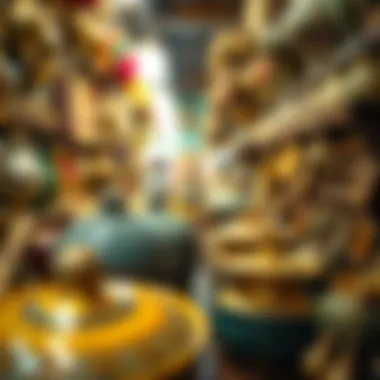
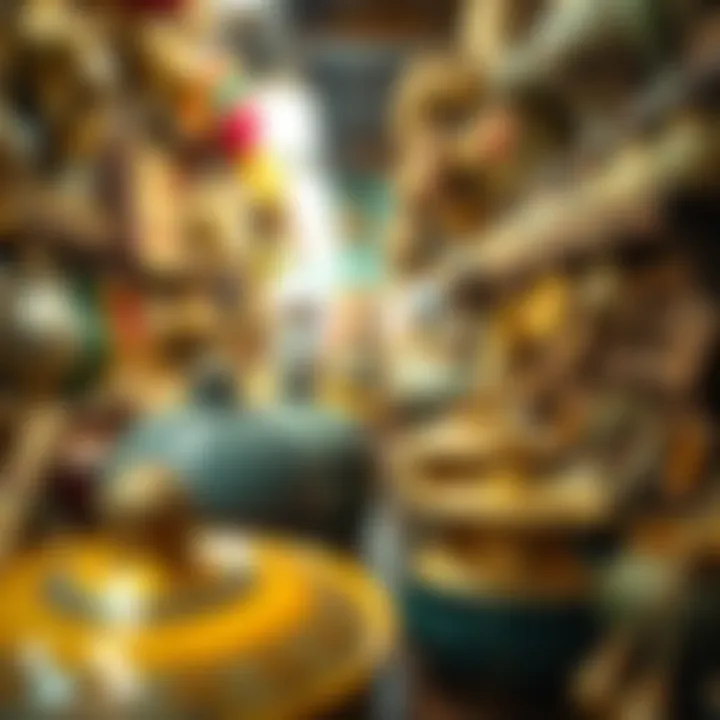
Shopping and Experiences
Exploring the Old Souk in Dubai offers more than just an avenue for purchases; it’s about diving headfirst into the very essence of Emirati culture. This marketplace serves up a feast for the senses, where shopping intertwines seamlessly with the experiences that paint the cultural landscape of Dubai. Visitors, whether locals or tourists, find that the hustle and bustle of the market revives both the spirit and the appetite, drawing an array of individuals keen to embrace the vibrancy surrounding them.
Authentic Souvenirs
In the heart of the Old Souk, one can find an array of authentic souvenirs that tell a story. Unlike items one might find in typical commercial shops, the offerings here include handmade crafts, traditional textiles, and vibrant ceramics that evoke a sense of place. Imagine leaving with a colorful Persian rug or perhaps a locally crafted piece of jewelry, each item steeped in history.
Engaging with local artisans adds another layer to the shopping experience. As you discuss their craft and the tales behind their work, it’s not just about acquiring a product but rather about gaining a glimpse into the local tradition. Items such as spices, incense, and traditional coffee pots are among the most sought after, each carrying with it a part of the local lifestyle.
"Buying a souvenir from the Old Souk is not merely a transaction—it's a connection to a rich tapestry of culture and craftsmanship."
Local Cuisine Offerings
The culinary landscape within the Old Souk is like a treasure trove for food lovers. Visitors can find a delightful array of local cuisine offerings that tempt even the most discerning palates. Traditional dishes such as shawarma, falafel, and hummus are easily discoverable at small stalls, each boasting its own unique twist on classic recipes.
In addition, the sweet aroma of local spices fills the air, luring you towards stalls packed with dates in numerous varieties, many of which are stuffed or coated in nuts. These local delicacies are not just food; they are an experience waiting to be had. Be sure to sample a cup of Arabic coffee, known for its slight bitterness and served with a hint of cardamom, offering a taste so memorable that one sip leaves you longing for more.
Cultural Performances
The Old Souk is not just about shopping and eating; it's also a hub for cultural performances that enchant visitors and enhance the overall experience. Traditional music often drifts through the air, with musicians playing oud and drums that invite passersby to pause and soak it all in. From belly dancing to folkloric shows demonstrating ancient Emirati traditions, these performances serve to celebrate the vibrant culture that the Old Souk represents.
Such events are often scheduled during busy times, especially on weekends, making it a perfect way to engage with the rich tapestry of local traditions. Observing or even participating in a dance can round out your visit, allowing for a direct connection to the heritage of the United Arab Emirates.
With a blend of authentic shopping, irresistible local cuisines, and captivating cultural performances, the Old Souk stands as a testament not just to commerce but to the cultural soul of Dubai, offering visitors an experience they won’t soon forget.
Visitor Tips
Visiting the Old Souk can be a delightful experience, but like any bustling market, it comes with its own set of tips that can make your journey smoother. Understanding these insights can greatly enhance your exploration, help you avoid pitfalls, and enrich your interaction with the local culture. These tips aren’t just for tourists but are equally beneficial for locals seeking to enjoy this vibrant marketplace with renewed perspective.
Optimal Visiting Times
Choosing the right time to visit the Old Souk can significantly affect your experience. Mornings and late afternoons are generally the best times to stroll through the narrow streets. The sun is less intense during these hours, making it comfortable to explore. Additionally, many vendors will be freshly stocked, bringing energy to the market as they prepare for the day or wind down from it.
Weekdays, specifically from Sunday to Thursday, tend to be quieter than weekends. If you’re looking to have a leisurely pace without being elbowed in the ribs by crowds, try to plan your visit accordingly. However, weekends can offer a lively atmosphere, with many locals flocking to engage with the merchants, so if you enjoy a more spirited vibe, weekends might be your preference.
Safety and Security Guidelines
While Dubai is considered one of the safer cities in the world, it always pays to stay vigilant, especially in crowded areas like the Old Souk. Here are several guidelines to keep in mind:
- Be Aware of Your Surroundings: Keep your personal belongings secure and close to you. It’s easy to get lost in the charm of the market, but maintaining awareness can help prevent pickpocketing.
- Stay Hydrated: The warm climate can take its toll. Drinking water regularly will keep you alert and energized as you explore.
- Use ATMs Wisely: If you need cash, use ATMs located inside shops or well-lit areas. Avoid withdrawing large amounts of cash at once; it’s safer to take out smaller amounts as needed.
"Safety comes first; enjoy the vibrant culture while being aware of your surroundings."
Local Etiquette
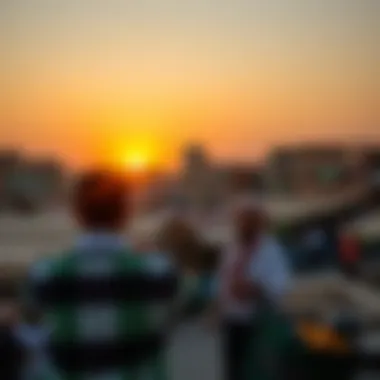
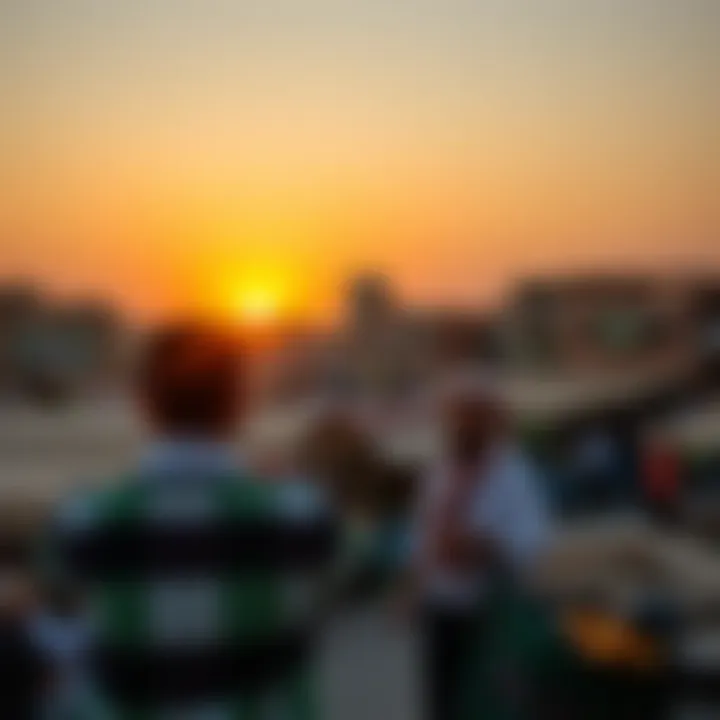
Cultural customs can differ from what many might be used to, especially in a city like Dubai that combines tradition with modernity. Familiarizing yourself with local customs can significantly enhance your interaction with vendors and residents alike. Consider the following:
- Dress Modestly: While Dubai is relatively liberal compared to other regions in the Middle East, it’s still wise to dress conservatively, especially in traditional areas like the Old Souk. Loose, breathable clothing is a good choice.
- Bargain Respectfully: Haggling is a part of the shopping experience here. However, it's essential to do so in a friendly manner. Start with a smile and a respectful tone—it can go a long way in creating a positive encounter.
- Respect Cultural Practices: Practicing patience and politeness is key. If you’re invited to share a drink or engage in conversation, it’s a generous gesture to accept.
By following these visitor tips, not only do you ensure a more pleasant experience for yourself, but you also show respect toward the local community and its customs.
The Future of the Old Souk
The Old Souk stands as a testament to Dubai's rich history and a point of cultural convergence. As urban landscapes transform, the future of the Old Souk brings with it pressing importance, particularly for stakeholders such as investors, homebuyers, realtors, and local business owners. It’s not just about preserving history but about ensuring that this vibrant space continues to thrive in a modern context. Key elements include preservation efforts, the integration with contemporary Dubai, and the impact on the local economy.
Preservation Efforts
Preservation of the Old Souk is vital not only for maintaining its historical significance but also for enhancing its appeal to both tourists and locals. Organizations, both governmental and non-governmental, are engaged in initiatives focused on restoring and maintaining the traditional architecture and ambiance of the market.
- Restoration projects involve reusing traditional materials and techniques.
- Community involvement is promoted through workshops that teach the artisanship of local crafts.
- Sustainable practices are prioritized to safeguard the environment while preserving the site.
"To keep our history alive, we cannot just let it age in vain; we must keep it fresh for the coming generations." These preservation efforts ensure that the Old Souk remains a lively hub reflecting the culture rather than a relic of the past.
Integration with Modern Dubai
As Dubai continues to position itself as an international hub, the integration of the Old Souk into the broader modern cityscape presents unique opportunities and challenges. The key is to blend the wealth of history with modernity in a way that does not overshadow the essence of the Souk.
- Mixed-use developments nearby may include hotels, restaurants, and shops, drawing even more visitors denoting a shift towards the future.
- Cultural events are being organized to highlight traditional crafts while incorporating modern marketing strategies.
- Technology, such as mobile applications, are being deployed to provide tourist information and enhance the visitor experience.
This thoughtful integration can elevate the Old Souk from a historical site to a landmark that resonates with both tradition and the pace of modern life.
Impact on Local Economy
The success of the Old Souk can also be measured through its impact on the local economy. Not simply a tourist attraction, the Souk serves as a vital component of Dubai's economic framework.
- Job Creation: The market provides employment opportunities for local artisans, vendors, and service staff, sustaining families and communities.
- Increased Tourism: As a cultural hotspot, the Old Souk attracts visitors from around the world, funneling money into local businesses and raising the profile of nearby developments.
- Investment: Development efforts around the Souk may entice further investment in various sectors such as real estate and hospitality.
The Old Souk has the potential to be a cornerstone of economic dynamism, intertwining its narrative with Dubai's modern aspirations while ensuring communities thrive in the balancing act of progress and preservation.
End
Understanding the Old Souk in Dubai is far more than just a regular visit to a marketplace. It’s an immersion into the threads of history that knit together the fabric of modern Emirati culture. The Old Souk serves as a reminder of the trade routes that once defined the region, showcasing the endurance of traditions amidst rapid modernization. The juxtaposition of time-honored craft and contemporary prosperity prompts a unique reflection on identity and heritage.
Summarizing Key Points
In summary, several key elements stand out regarding the Old Souk:
- Historical Relevance: The souk has played a pivotal role in Dubai's development, reflecting the city’s transition from a humble fishing village to a global trade hub.
- Architectural Charm: Its narrow lanes and traditional wind towers offer a glimpse into the past, inviting visitors to appreciate local craftsmanship.
- Cultural Experiences: Engaging with local merchants and sampling culinary delights fosters a deeper understanding of Dubai’s rich tapestry.
- Visitor Insights: Knowing optimal visiting times and respecting local customs enhances the overall experience, making it more rewarding for tourists and locals alike.
The Old Souk encapsulates the essence of Dubai, serving as both a shopping destination and a historical site. It influences not just the local community but also the global visitors eager to explore its wonders.
Reflecting on the Current Experience
As one traverses the bustling alleyways of the Old Souk today, a sense of connection emerges. The bustling energy and the rich aroma of spices awaken the senses, making each step feel like a dance between the old and the new. Visitors often find themselves lost in thought, contemplating the stories that resonate within the very stones of the market.
The ongoing preservation efforts underscore the community’s commitment to safeguarding this cherished landmark. Whether you’re negotiating for a handwoven carpet or simply soaking in the vibrant atmosphere, the experience feels authentically local. The Old Souk isn’t merely a destination; it’s a living narrative that evolves while honoring its roots.
Ultimately, it leaves travelers with more than just memories of their purchases; they carry away fragments of culture and a deeper appreciation for the heritage that defines Dubai. For both investors and homebuyers keen on understanding the fabric of local life, the Old Souk presents invaluable insights, making it a cornerstone of Dubai's marketplace and cultural identity.















